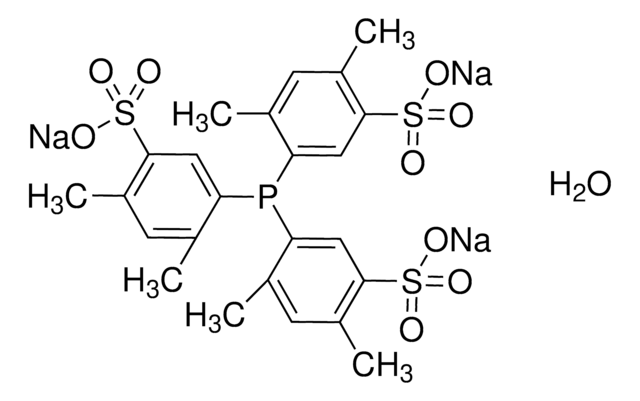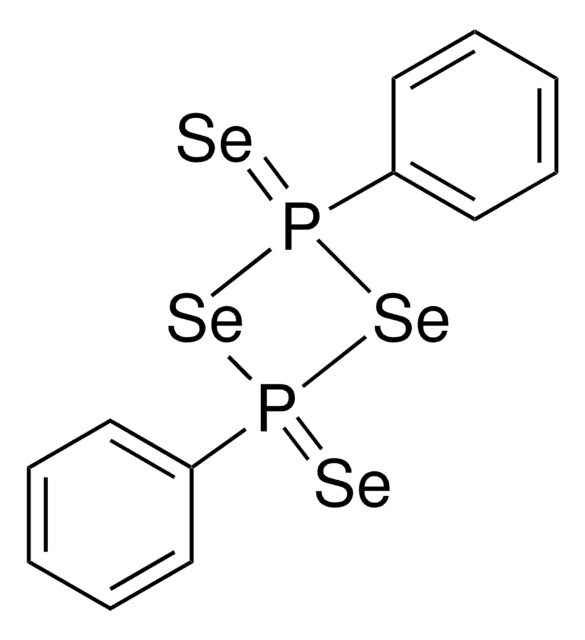08902
Triphenylphosphine oxide
analytical standard
Sinônimo(s):
Ph3PO, TPPO, Triphenyl phosphorus oxide, Triphenylphosphine monoxide
About This Item
Produtos recomendados
grau
analytical standard
Nível de qualidade
Ensaio
≥98.5% (HPLC)
prazo de validade
limited shelf life, expiry date on the label
técnica(s)
HPLC: suitable
gas chromatography (GC): suitable
pf
150-157 °C (lit.)
aplicação(ões)
pharmaceutical
formato
neat
cadeia de caracteres SMILES
O=P(c1ccccc1)(c2ccccc2)c3ccccc3
InChI
1S/C18H15OP/c19-20(16-10-4-1-5-11-16,17-12-6-2-7-13-17)18-14-8-3-9-15-18/h1-15H
chave InChI
FIQMHBFVRAXMOP-UHFFFAOYSA-N
Procurando produtos similares? Visita Guia de comparação de produtos
Aplicação
- Fluoride sensing in coordination polymers: Triphenylphosphine oxide is utilized in the development of lanthanide-based coordination polymers for selective fluoride sensing, demonstrating its utility in intramolecular proton transfer mechanisms for enhanced detection capabilities (Singh et al., 2024).
- NMR shielding calculations: The compound′s influence on solvent effects and convergence of phosphorus-31 NMR shielding calculations is explored, highlighting its role in computational chemistry for better understanding molecular interactions (Calcagno et al., 2024).
- Hydrogen bond characterization: Triphenylphosphine oxide is investigated for its interactions with substituted phenols, where shifts in phosphorus-oxygen stretching bands are analyzed to characterize hydrogen bonds, enhancing our understanding of molecular dynamics in phosphine oxides (Kostin et al., 2024).
- Advances in utilization: A review discusses the broad applications of triphenylphosphine oxide beyond its traditional uses, focusing on its emerging roles in various chemical transformations and its potential in catalytic processes (Zhang and Han, 2024).
- Covalent bonding studies with lanthanides: The role of 4f-orbitals in forming covalent bonds between lanthanides and triphenylphosphine oxide is examined using X-ray absorption spectroscopy and density functional theory, providing insights into the electronic structure and bonding behavior in these complexes (Zhang et al., 2024).
Nota de análise
Outras notas
The collision cross section (CCS) measurement was provided by Waters Corporation, using the SYNAPT XS mass spectrometer.
For a description and overview of how ion mobility enables the measurement of the CCS of an ion visit ims.waters.com.
Further information on the SYNAPT XS mass spectrometer can be found on the IMS microsite and product webpage.
TWCCS measurements are expected to be within 2% of this reference value.
P/N 08902 is part of the Waters Extractables & Leachables UNIFI scientific library which can be downloaded from Waters Marketplace.
Produtos recomendados
Palavra indicadora
Warning
Frases de perigo
Declarações de precaução
Classificações de perigo
Acute Tox. 4 Oral - Aquatic Chronic 3
Código de classe de armazenamento
11 - Combustible Solids
Classe de risco de água (WGK)
WGK 2
Ponto de fulgor (°F)
356.0 °F
Ponto de fulgor (°C)
180 °C
Choose from one of the most recent versions:
Já possui este produto?
Encontre a documentação dos produtos que você adquiriu recentemente na biblioteca de documentos.
Nossa equipe de cientistas tem experiência em todas as áreas de pesquisa, incluindo Life Sciences, ciência de materiais, síntese química, cromatografia, química analítica e muitas outras.
Entre em contato com a assistência técnica









